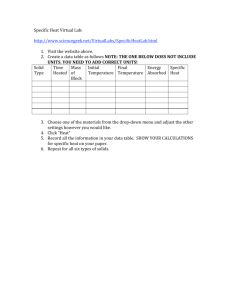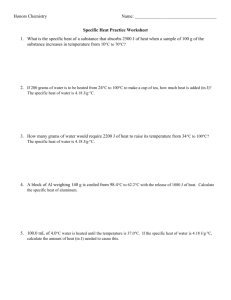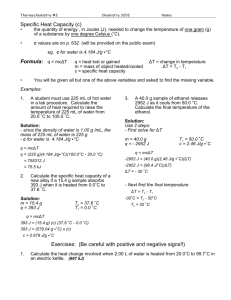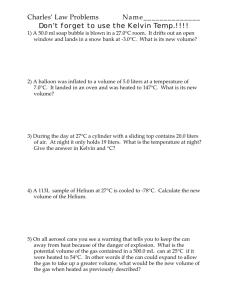Linear Expansion coefficient
advertisement
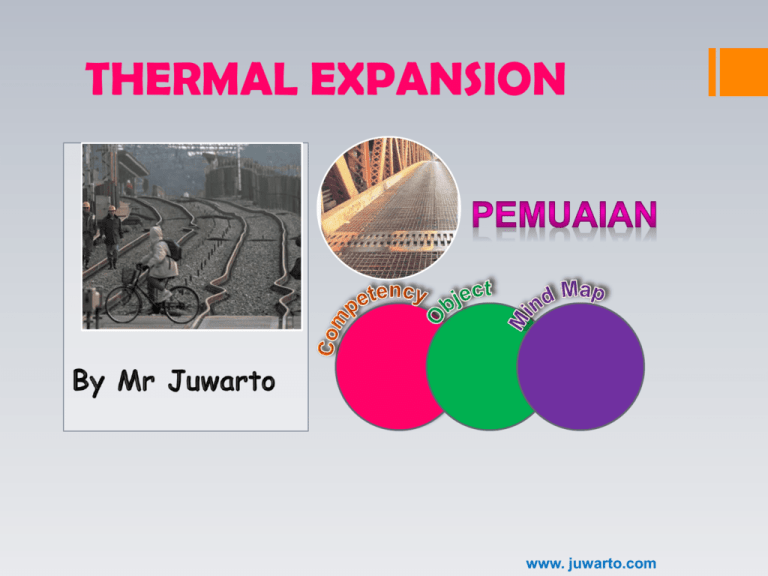
THERMAL EXPANSION www. juwarto.com Standard Competency: Understanding state of matter and their change Basic competence Doing experiment relate to expansion and apply in daily life. Indicator to achieve competence To take simple experiment for showing expansion in solid, liquid and gas. Find expansion process, in solid, liquid and gas. To show expansion in solid, liquid, gases, and their technology Glossary Heat = Panas Heated = dipanaskan Cooled = didinginkan Expansion = Pemuaian Expand = Memuai Contraction = penyusutan Contract = Menyusut Linear expansion coefficient = Koefisien muai panjang Area expansion coefficient = Koefisien muai luas Volume expansion coefficient = Koefisien muai volume Why a gap is given between rail roads? Why bridge connectors are given a space? Expansion Solids will expand when it is heated and contract when it is cooled. Expansion is INCREASE in size when an object is heated. When heated, the atoms and molecules of the matter will vibrate faster than usual because of the high temperature Therefore Atoms and molecules need more space then the matter will expand to any direction 1. Linear Expansion l0 Δl 2. Area Expansion A ΔA 3. Volume Expansion Thermal Expansion Expansion of solid Linear expansion Area expansion Expansion of liquid Volume expansion Expansion of gas Linear Expansion (pemuaian panjang) Influences by: 1. Kinds of Solid 2. The length of an object 3. The change of Temperature Linear Expansion coefficient (α) •is a value that states the rate of an expansion speed of an object per temperature degree •The Higher linear expansion coefficient of an object is, the faster the object will expand Linear Expansion lo lt lo l l lt l lo T lt= Final length (m) lo= Initial length (m) Δl = length expansion (m) α= Linear expansion coefficient (/ C ˚) ΔT= Changes of temperature(C ˚) Example 1: 1. A steel railway track is 40 metres long at 0 °C. How long is its expansion if it is heated up to 100 °C? (αsteel = 0.000011/C°) Given : lo = 40 m T1 = 0 °C ΔT = T2 -T1 = 100 C° T2 = 100 °C αsteel = 0.000011/C° Question: Δl Answer Δl = α. lo . ΔT = 0.000011/C° . 40 m . 100 C° = 1.1 x 10-5 .4 x 101 . 1 x 102 m = 4.4 x 10-2 m = 0.044 m A steel bridge is 100 m long at 20 °C. What is the final length if its heated until 80 °C?(α steel is 0.000011/ C °) Exercise 1. A copper bar at 15°C is 20 metres long, then it is heated up to 35°C. Determine how much its length will expand during the heating process if its expansion coefficient is 0.000017/ C°. 2. An iron bar at 20˚C is 3 meter long, and then it is heated up to 100˚C. Determine the final length of bar if linear expansion coefficient (α) is 0.000012/C˚? 3. A Pyrex glass with initial length of 5 meters is heated up 50Co from initial temperature. Determine the length expansion of that glass if its length expansion coefficient is 0.000004/C0. 4. The length of steel bar (α= 0.000012/C°) at temperature of 30°C is 50 cm. If the length of that steel bar becomes 50.011 cm, the temperature increase is 5. You’re heating a 2.5 m lead bar, coefficient of linear expansion 2.9 × 10–5 /C°, raising its temperature by 40C°. What is the final length of the bar? Answer these questions correctly! 1. What is expansion? Explain. 2. Give 3 examples of expansion in daily life! 3. When do the objects expand? Explain. 4. Mention the factors that influence expansion! 5. What kind of formula to find the changing of length of linear expansion! 6. What instrument do you use to find the linear expansion? 7. The initial length of iron is 30 m at 25 ˚C. if it’s heated up to 90 ˚C. Determine the length of iron after being heated. (linear expansion coefficient of iron is 0.000012 /C˚)! At = Ao +A At Ao A Ao T A = x Ao xT A = change in Area (m2) = Area expansion coefficient (/Co) = Initial Area (m2) = change in temperature (Co) = 2α Vt = Vo + V Vt Vo V = Vo t V = 3α = /C° For solid All gas V = change in Volume (m3) = Volume expansion coefficient (/Co) Vo = Initial Volume (m3) T = change in temperature (Co) LINEAR EXPANSION AREA EXPANSION VOLUME EXPANSION l THERMAL EXPANSION A Δl 0 0 ΔA l lo T lt lo l A Ao T At Ao A For solid 2 ΔV V0 V Vo T Vt Vo V 3 For solid 1 For Gas 273C 1. A plate of glass measures 100 m long and 50 m wide at 20 oC. What is its final area if the temperature is increasing until 70oC? (α = 0.9 x 10-5/C°) 2. A 200 cm3 Alcohol is heated from 25oC to 75 oC. Calculate the volume expansion of alcohol if volume expansion coefficient of alcohol is 0.0012 /Co. 3. Volume of kerosene at 5oC is 2 liter. If its heated until 105oC, how much the final volume of kerosene? (ɤ of kerosene is 0.000955 /Co). 4. The volume of glass cylinder at 10 oC is 1 liter. It’s full with alcohol. How much the spilled alcohol if it heated until 60 oC? (α glass = 0.000009/Co ; ɤ alcohol = 0.00120 /Co ) (spilled = tumpah) The examples of the use of expansion or contraction in daily life 1. Bimetallic strip Bonding two metals with dissimilar thermal expansion coefficients What will happen if we heated bimetallic strip? Bimetallic will bend to metal with the smallest linear expansion coefficient Example: Bimetallic strip which consist from brass and steel. Bimetallic strips will bend to steel direction, because: α brass = 1.9 x 10-5/C° α steel = 1. 1x 10-5/C° α brass > α steel HEATED α copper > α iron Bimetallic strips will bend to iron direction CONCLUSION: Bimetallic strips will bend to metal with the smallest linear expansion coefficient Bimetallic strips can be found on… T-Bimetal Thermometer Thermostat Automatic switch in an electric iron Fire Alarm Automatic switch FIRE ALARM The examples of the use of expansion or contraction in daily life 2. Thermometer 3. 4. Metal plates riveting (Pengelingan pelat logam) Installation of metal rims on wheels (Pemasangan bingkai logam pada roda) 5. Railway track joint (Sambungan rel kereta api) 6. Expansion joint on a bridge (Celah pemuaian pada logam) If a gas has a constant mass and is held at a constant pressure then the volume divided by the temperature is a constant value. The relationship between temperature and volume at constant pressure V1 V2 T1 T2 Note: V1 = Initial Volume V2 = Final volume T1 = Initial Temperature (Kelvin) T2 = Final Temperature (Kelvin) Example :Problems of Charles’s Law 1. The initial volume of a gas in piston is 100 cm3 and its temperature is 327°C. If the volume decrease until 50 cm3 while the pressure is constant, temperature of gas will become… Given :V1 = 100 cm3 V2 = 50 cm3 T1 = 327 °C Question : T2 = ?? Answer : First, Convert Temperature into Kelvin scale: T1 = (327+273) K = 600 K V1 V2 T1 T2 100cm3 50cm3 600K T2 100cm3 T2 50cm3 600 K 50cm3 600 K T2 300 K 3 100cm T2 = (300-273) °C = 27 °C 1. Gas volume at temperature of 27°C is 20 liters. If gas is heated in constant pressure, the volume of the gas when its temperature 127°C is…. 2. A 250 cm3 sample of neon is collected at 47 oC. Assuming the pressure remains constant, what would be the volume of the neon at 207 oC? 3. The initial volume of gas in a piston is 400 cm3 and its temperature is 600 K. If half of the gas volume is reduced at the constant pressure, its temperature is… Most substances expand when heated and contract when its cooled, but water is unusual 4°C 0°C (cooled) the water will expands 0°C 4°C (heated) the water will contracts Beside that range of temperature, water will experience normal expansion. This phenomenon makes water have the smallest volume at temperature of 4°C Thus, water will have the biggest density at 4°C The anomalous expansion of water helps preserve aquatic life during very cold weather. When temperature falls, the top layer of water in a pond contracts, becomes denser and sinks to the bottom. A circulation is thus set up until the entire water in the pond reaches its maximum density at 4°C. If the temperature falls further, the top layer expands and remains on the top till it freezes. Thus even though the upper layer are frozen the water near the bottom is at 4°C and the fishes etc. can survive in it easily.
